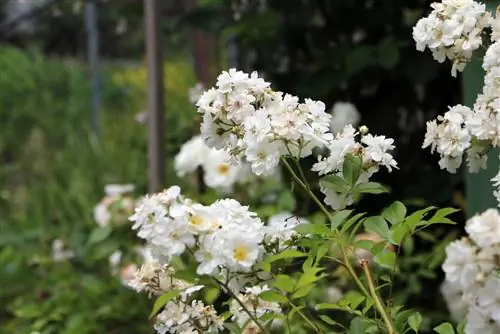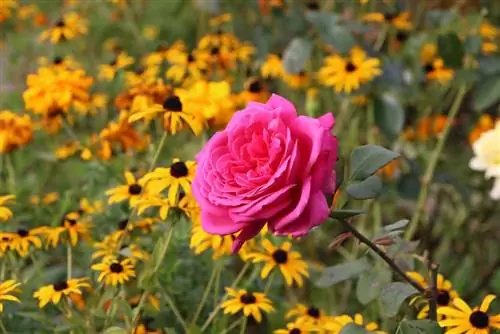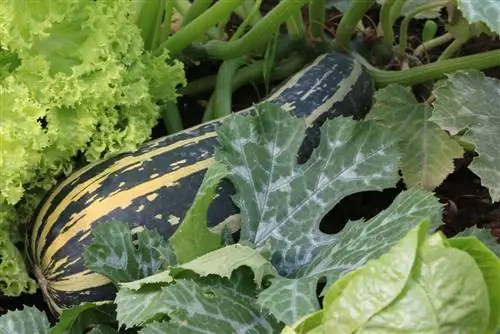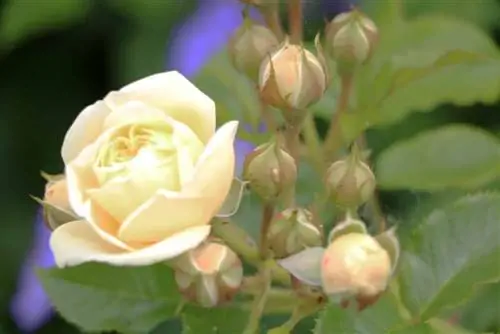- Author admin [email protected].
- Public 2023-12-17 03:39.
- Last modified 2025-01-24 12:45.
Withered roses should be removed regularly by pruning to ensure that they continue to bloom. A rose bush has strong regenerative properties, so it will not be damaged by pruning. Rather, faded inflorescences damage the plant, it quickly loses strength and new flowers no longer form. Only through targeted and periodic pruning of the faded roses will the plant remain vital and blooming. However, the cut must be targeted so that the rose bush does not become infected with pathogens.
Growth
Rose bushes have a lasting ability to regenerate; the flowers can develop back to their full size from just a single rose eye. Without cutting back the spent flowers, the gardener is not doing anything wrong, but the rose bush ages over time and can lose its bloom and vitality in just a few years. The faded rose petals continue to be supplied with nutrients by the plant, causing the plant to lose unnecessary strength. If these are not pruned, the energy goes into seed formation and no new buds are formed. The following aspects are crucial for growth:
- Flowered flowers must be cut off, otherwise they will age
- As a result, roses no longer produce any more young shoots, especially in the ground area
- Rosenstock becomes bald in this way over the years
- Cutting off stops the useless supply of dead rose petals
- Pruning helps with the formation of new flowers
- Prune strong growing shoots more gently
- Apply more radically for weakly growing shoots
- Without pruning, the branches grow too long in proportion
- Plant gains volume, but the shoots are not strong enough
- Shoots that are too long can no longer withstand wind and weather and break off
- In addition, a rose bush looks much more attractive without faded flowers
Instructions

Although roses tolerate pruning quite well, the pruning must be done in certain places so that the plant is not damaged and can recover promptly. If the cut is made incorrectly, it can quickly become infected with bacteria and fungal pathogens. However, not only the faded rose petals should be cut off, but also the leaves underneath. This allows the plant to maintain a designated growth direction. The following procedure has proven successful when pruning the faded rose petals:
- Prune approximately 0.5 cm above the first, fully developed leaf, which is located below the faded flower
- Cut off after one eye facing outward
- Cut diagonally away from a new shoot that is already visible
- Slanted cut prevents water from collecting at the cut wound
- Stem must never be left standing
- Never remove or break off the flower
- Frayed breaks promote the penetration of harmful pathogens
- Cancel also supports the sprouting of puny buds
- Withered roses on extremely thin and weak branches may be cut deeper
- Deep cuts encourage stronger growth
Tip:
The first leaf below the flower usually only has 3 leaves, whereas a fully developed leaf has more than 5 leaves. The first fully developed leaf should be left standing if possible, but the poorly developed leaf can still be cut off.
Time
The pruning of faded rose petals must be carried out in addition to the shaping care cuts. Therefore, the plant must be constantly monitored during its flowering period so that they can be removed relatively quickly:
- Cut out the spent flowers throughout the summer
- Check the rose bush regularly
- Flowering should not remain on the plant for too long
- Continuous removal of spent rose petals ensures strong and lush blooming plants
- Warm days without rain are ideal
- Dealing with weather conditions that are too hot, too cold and too wet
- Long-term high humidity leads to the penetration of pathogens at the interfaces
Tool

When pruning roses, the right equipment is not only necessary, but essential. The tool must meet high requirements so that extremely smooth and precise cuts can be made without causing unnecessary injury to the plant. If the rose shoot is severely bruised or even torn, it often happens that harmful bacteria and fungi can penetrate the injured areas. This causes the plant to lose its resistance and become more susceptible to disease. The following criteria are crucial when it comes to tools for pruning roses:
- High-quality pruning shears are required for cutting roses
- Special rose scissors, with a shape adapted to your needs, are ideal
- Bypass scissors are like normal household scissors, two blades slide past each other
- Bypass shears prevent bruising, especially on soft shoots
- Scissors with a bypass system require a higher but worthwhile effort
- Anvil pruners feature a sharp blade that strikes a straight plane
- Anvil pruners make cutting thicker shoots easier
- However, scissors with an anvil system often lead to damaging injuries
- Always disinfect scissors well before use and sharpen if necessary
- To disinfect, either use denatured alcohol or burn blades
- There are extended rose shears for tall climbing roses
Tip:
Not only the roses should be protected from injuries, the gardener's hands also benefit from additional protection in the form of robust gloves. When working with the prickly thorny plant, these offer good protection against cracks and cuts, which can lead to painful inflammation.
Rose varieties
The procedure for cutting off the spent rose petals also differs depending on the rose variety, which determines the growth and formation of the flowers. These include the following varieties: bed and noble roses, climbing roses (blooming once or more), rambler roses, standard roses, shrub roses (blooming once or more), wild roses and dwarf roses. The following aspects should be taken into account when it comes to rose varieties:
- On poorly flowering shrub roses, cut back the rotten shoots to two thirds
- For bedding and noble roses, cut back older shoots more heavily
- Climbing roses do not produce flowers in the first few years of life
- Wild roses form beautiful and bright red rose hips, leave them standing
- On standard roses, generously cut off old shoots in favor of young shoots
- On rambler roses, only cut back the strong, dead shoots, proceed carefully with the rest
- For dwarf roses, pay attention to a hemispherical cut shape
Conclusion
Rose petals should be cut out as quickly as possible after they have faded so that the plant does not feed the dead shoots unnecessarily. Therefore, the rose bushes must be checked regularly during the flowering period in summer so that action can be taken promptly. If faded roses remain attached to the plant, it will weaken and age over time. In the long run, aging leads to stunted shoots and increasingly weak flowers. In addition, withered flowers on a rose bush do not look particularly attractive and reduce the overall attractive impression. When pruning, the cut point is crucial; it should be below the withered flower but still above the first fully developed leaf. However, poorly developed shoots may be cut off more radically, which will also increase growth and flowering. Furthermore, the tool used for cutting is very important; it should always be clean and sharp. In this way, the plant is not disproportionately bruised and injured, because pathogens can penetrate more easily through cuts and permanently weaken the rose bush.






